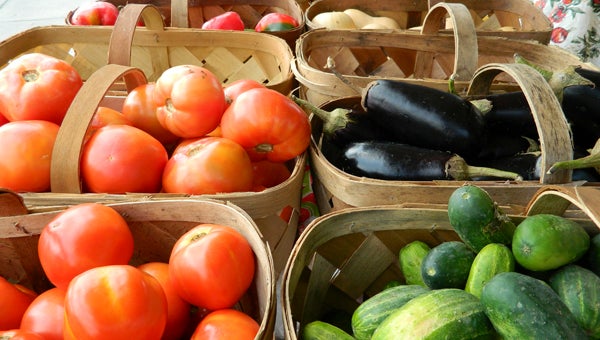GARDENING TIPS: How to grow good tomatoes
Published 6:54 pm Saturday, April 19, 2014

FILE PHOTO | DAILY NEWS
PRODUCE: At the Saturday Market attendees will find produce and other tasty items.
Much success in growing tomatoes can be attributed to use of a few proven techniques.
First, start by selecting varieties that are proven performers. Better Boy, Whopper, and Celebrity are resistant to verticillium wilt, fusarium wilt, and root-knot nematodes. Don’t be afraid to experiment with other tomato varieties.
Second, prepare the soil. Clay and sandy soils will need to be amended by incorporating 2 to 3 inches of compost into the top 8 inches of soil. Use raised beds to improve soil drainage. Add lime and fertilizer according to NCDA soil test recommendation. In lieu of NCDA soil test, apply ¾ cup of lime and ½ cup of 8-8-8 fertilizer for each plant.
Next, prepare a starter fertilizer solution to be used at planting. Starter fertilizer solution consists of 3 Tbsp of 8-8-8 mixed in one gallon of water. Use one cup of solution per transplant.
Now, dig holes deep enough to cover the root balls so that they don’t dry out. Allow 1½ to 2 feet spacing between plants. Leggy plants can be planted using the trench method. Dig a trench and lay the plant in the trench with only top leaf and stem uncovered. All other leaves except the top leaf should be removed from stem.
After planting, a cage or stake should be placed next to each plant. Stakes produce bigger (but few) tomatoes and require suckering. Use string or surveying tape to “tie up” tomatoes to the cage or stake as plants grow.
Sidedress each tomato plant with three Tbsp. of 8-8-8 when the plants begin to set fruit and four to six weeks thereafter. Avoid fertilizer burn by applying the sidedress material six inches from the stems of the plants.
Lastly, blossom-end rot (dry brown area on bottom of tomato) can be prevented by supplying 1.5 inches of water per week during fruit development. Extreme swings in soil moisture cause the disorder (either too dry or too wet). Use mulch (straw or pine straw) to help conserve moisture. A foliar application of calcium chloride can be used to “rescue” plants that are beginning to show signs of blossom-end rot. Applications should be made in the morning when temperatures are cool. Do not exceed the recommended rate.
Would you like to have a garden of your own but don’t have the space? If so, join the Beaufort County Community Garden! Plots start at $20 per year. Contact the Beaufort County Extension Office for more information 252-946-0111.
Looking to buy some great plants and/or decorations for your garden? Come on down to the Extension Master Gardeners Annual Plant Sale on May 17, from 9 a.m. to noon (rain or shine). For more information call 252-946-0111 or visit ncEMGV.org
Jacob F. Searcy is the Extension Agent, Agriculture-Horticulture, Beaufort County Center of North Carolina Cooperative Extension Service.
SIDEBAR:
TITLE: Gardening Calendar for April
Lawn Care
- Warm season grasses like Bermuda and centipede can be seeded or sprigged.
Fertilizing
- Early blooming flowers like forsythia and evergreens like holly can still be fertilized.
- Rhododendrons, azaleas, and other late bloomers should be fertilized as soon as their flowers fade.
- Fruit trees can be fertilized now especially if there are going to bare much fruit. A good rule of thumb is to use one pound of 10-10-10 for each year of tree age. It’s best to apply half in late winter and the remainder in May. Don’t apply the remaining fertilizer if the crop is killed by frost.
Planting
- Azaleas can be planted this month while they are flowering. Some gardeners do this so they can better arrange the different colors.
- Annual flowers can be planted. Examples would be: ageratum, begonia, celosia, dwarf dahlia, dusty miller, geranium, marigold, petunia, portulace, salvia, snapdragon, and annual vinca.
- Gladioli bulbs can be planted now and continue till mid-June.
- Plant beans, beets, cantaloupe, corn, Chinese cage, cucumbers, pumpkin, squash, Swiss chard, and watermelon later this month.
Propagation
• Shrubs can be layered by lowering one of the branches to the ground and covering it with soil. Use a rock to hold the branch down till it takes root.
Pruning
- Faded April bloomers like azaleas can be pruned as soon as the flowers fade.
- Berry producing plants like holly and pyracantha should be pruned while they are flowering this month.
Spraying
- Watch shrubs for: lace bugs on azaleas, leaf miners on boxwoods, tea scale on camellias, scale on euonymus, spider mites, and hybrid rhododendron borers.
- Spray iris beds for iris borers.
- Spray squash plants for squash borers.
- Begin weekly sprayings of fruit trees as soon as the flowers fall off.
- Continue with rose spraying program.
- Always follow the label and don’t spray insecticides unless damage causing insects are seen.
Other Activities
- Mulch landscape plants to keep weeds from growing and to conserve water.
- Keep records of what was planted and when chemicals were sprayed





